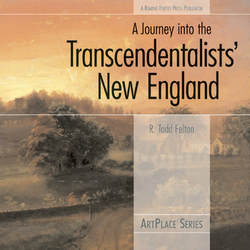Читать книгу A Journey Into the Transcendentalists' New England - R. Todd Felton - Страница 17
The Hudson River School
ОглавлениеAs Emerson urged the American scholar, in a famous 1837 address at Harvard, to turn his back on the “courtly muses of Europe” in order to create a truly American tradition, the visual artists of the Hudson River School were doing just that. Following the lead of Thomas Cole, a group of painters, mostly living in the Hudson River valley of New York State, were painting sweeping landscapes filled with light and color. Essentially concurrent with Transcendentalism, the Hudson River School, active from 1835 to 1870, was the first native school of American art.
Artists such as Thomas Cole, Thomas Doughty, Asher Durand, Frederic Church, and George Gatlin sought to display a vast wilderness filled with promise for the small yet uplifted human figures shown communing with it. Many key Transcendentalist themes—inspiration from the natural world, the spiritual unity found in nature, friendship among men of ideas—can be found in the works of the Hudson River School. For example, in James Hamilton’s painting Scene on the Hudson the human figure is dwarfed by the scale of the natural world.
Scene on the Hudson by James Hamilton (1845).
Walden Pond continues to be enjoyed by fishermen and literary pilgrims alike.
In 1836, the Massachusetts Supreme Court ruled that any slave brought within the state’s borders by a master would be a free person. The next twenty-seven years, leading to the 1863 Emancipation Proclamation, brought further successes for the antislavery movement, such as the organization of the Underground Railroad in 1838, as well as losses, such as the 1857 Dred Scott decision, in which the U.S. Supreme Court ruled that Scott, born a slave, could never be a free man because slaves were property, not citizens. By the time John Brown led twenty-one armed men in an assault against the federal arsenal at Harpers Ferry, Virginia, in 1859, the nation was already beginning to break apart over the issue of slavery.
These events were being reported to the country’s citizens at an increasingly rapid pace. With the proliferation of newspapers in the early part of the nineteenth century, and basic literacy for white adults near 90 percent by midcentury, people had unprecedented access to news and ideas filtered through a variety of perspectives (temperance, abolitionist, Christian, suffragist, and so on). Newspapers, magazines, and cultural figures were beginning to rival the clergy as influences on the ideas and values of the lay public.
The Transcendentalists, for their part, succeeded as a philosophical and literary movement because they did not demand adherence to a doctrine or prescribe a set of rules. Transcendentalism valued each individual as a spirit equal to and intimately connected to another. It encouraged each soul to develop its own original relationship with the universe, based on its particular situation.
That is why the Transcendentalism that Emerson spoke about to Harvard Divinity School students in 1838 could be felt and explored by Emily Dickinson twenty years later, some ninety miles to the west. What Thoreau accomplished by living at Walden Pond exemplified the same values and ideals that brought hordes of people to Boston’s Music Hall to hear Theodore Parker preach. Transcendentalism provided New Englanders with a uniquely American philosophy, one of individuality and idealism, intimately tied to place ... their place.
